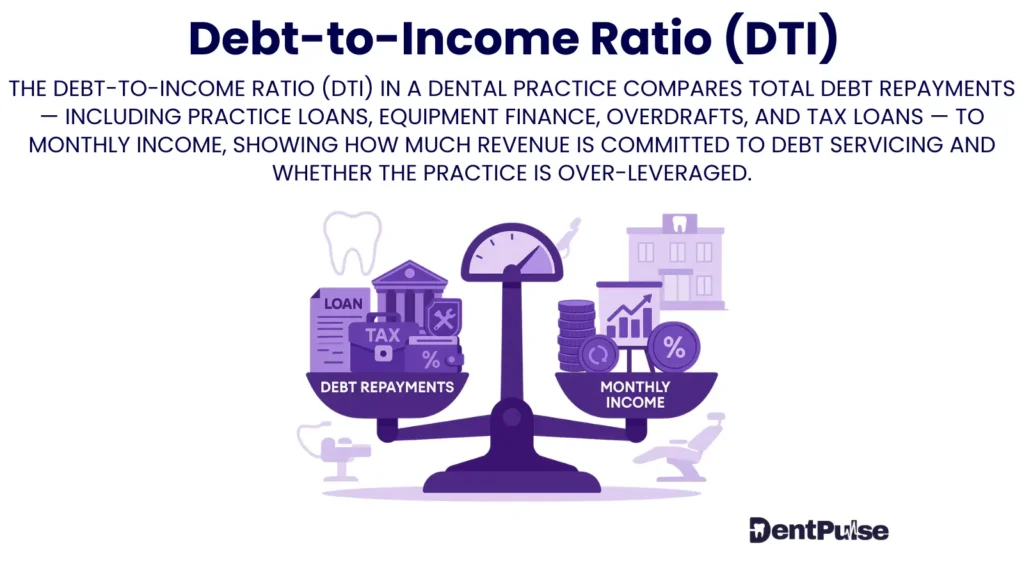What Is the Debt-to-Income Ratio (DTI) in a Dental Practice?
The Debt-to-Income Ratio (DTI) measures how much of a dental practice’s income is committed to servicing debt.
It is a key indicator of borrowing capacity and financial risk, used by banks, lenders, and buyers when assessing the stability of a practice.
Why Does DTI Matter for Dental Practice Owners?
A high DTI signals that too much revenue is consumed by loan repayments — leaving little room for reinvestment, drawings, or cash buffer building.
- ✅ Low DTI → lenders see practice as low-risk and scalable
- ⚠️ High DTI → lenders may refuse further loans or impose higher interest rates
Example:
- Total annual debt repayments: £180,000
- Annual gross income: £1,000,000
- DTI = 18% → healthy
If repayments rise to £400,000, DTI = 40% → high risk.
How Is Debt-to-Income Ratio Calculated?
DTI (%)=Total Annual Debt RepaymentsAnnual Gross Income×100\text{DTI (\%)} = \frac{\text{Total Annual Debt Repayments}}{\text{Annual Gross Income}} \times 100DTI (%)=Annual Gross IncomeTotal Annual Debt Repayments×100
- Debt Repayments = principal + interest across all loans
- Income = gross practice revenue (NHS + private + plans)
What Is a Healthy DTI for Dental Practices?
- 🟢 < 25% → Strong borrowing position
- 🟡 25%–35% → Manageable but monitor closely
- 🔴 > 35% → High risk, limits growth and refinancing options
How Does DentPulse Track and Optimise DTI?
| Feature | Function |
| Loan Register | Centralises all loan repayments (acquisition, equipment, tax, working capital) |
| CFFP™ Integration | Builds DTI into 13-week and multi-year forecasts |
| Profit-to-Pocket™ Overlay | Shows how debt affects safe take-home pay |
| OWS™ (Owner Wealth Score) | Scores financial resilience, factoring in DTI |
| Scenario Planning | Models effect of refinancing or early repayment on DTI |
DentPulse ensures DTI isn’t just a lender’s number — it becomes an owner’s decision tool.
DentPulse Tip™
“Banks use DTI to protect themselves.
Use it to protect your profit-to-pocket.”
Related Glossary Terms
- Debt Servicing – monthly/annual repayments on practice loans
- Practice Loans – borrowing for acquisitions or refurbishments
- Refinancing – restructuring debt to improve DTI
- CFFP™ – future cash flow pairing model
- OWS™ (Owner Wealth Score) – long-term wealth resilience diagnostic
Glossary Summary Table
| Term | Meaning |
| Debt-to-Income Ratio (DTI) | % of income spent on servicing debt |
| Purpose | Measures borrowing capacity and financial health |
| DentPulse Advantage | Live DTI tracking, scenario planning, and wealth impact scoring |




